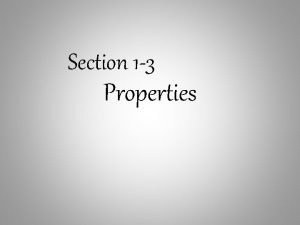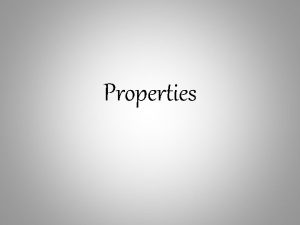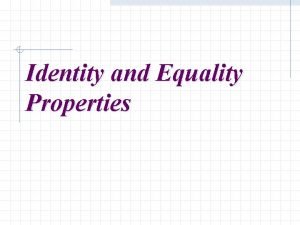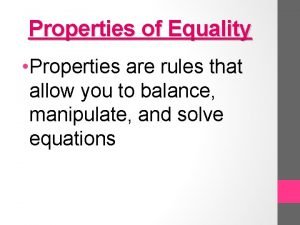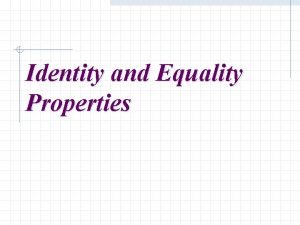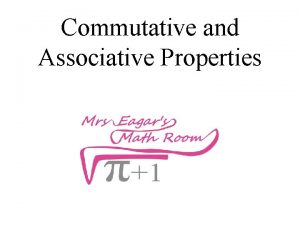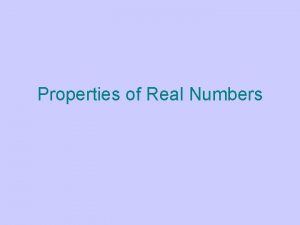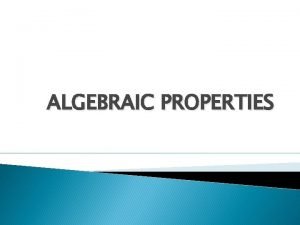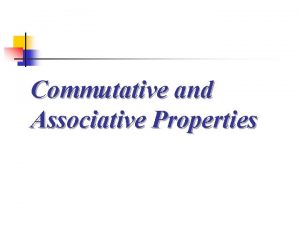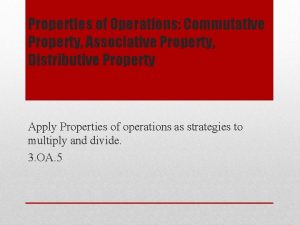Properties of Equality Identity and Operations Commutative Property











- Slides: 11

Properties of Equality, Identity, and Operations

Commutative Property a+b=b+a (a)(b) = (b)(a) • The Commutative Property states that the order of the numbers may change and the sum/product will remain the same. • This property applies to both addition and multiplication. 2+3=3+2 (2)(3) = (3)(2)

Associative Property (a + b) + c = a + (b + c) (a · b) · c = a · (b · c) • The Associative Property states that the grouping of numbers can change and the sum/product will remain the same. • This property applies to both addition and multiplication. (2 + 4) + 5 = 2 + (4 + 5) (2 · 4) · 5 = 2 · (4 · 5)

Distributive Property of Multiplication a (b + c) = a(b) + a(c) a (b – c) = a(b) – a(c) • The Distributive Property takes a number and multiplies it by everything inside the parentheses. • This property works over addition and subtraction. 2(3 + 4) = 2(3) + 2(4) 2 (5 – 2) = 2(5) – 2(2)

Substitution Property Solve: y = 2(x) + 4 if x = 5 • This property allows you to simplify algebraic expressions for different values. You substitute the given value of the variable into the equation and solve. y = 2(5) + 4 y = 10 + 4 y = 14

Identity Properties n·1=n n+0=n • This property shows how a given number is itself when multiplied by 1 or added to 0. • These are important concepts to understand when solving single and multi-step equations. • The one and zero act like mirrors. 4·1=4 5+0=5

Zero Property of Multiplication n·0=0 Simply stated, any number times zero equals zero.

Multiplicative Inverse Property ½ (2) = 1 • This property is helpful when solving equations where there is a fraction “attached” to a variable by multiplication. The normal inverse operation for multiplication is division, but in this case, you will multiply both sides of the equation by the reciprocal of the fraction. ½n– 3=4 ½ n -3 + 3 = 4 + 3 ½n=7 ½ n (2) = 7(2) n = 14

Transitive Property If a = b and b = c, then a = c If one quantity equals a second quantity and the second quantity equals a third quantity, then the first equals the third. If 1000 mm = 100 cm and 100 cm = 1 m, Then 1000 mm = 1 m

Symmetric Property If a + b = c then c = a + b If one quantity equals a second quantity, then the second quantity equals the first. If 10 = 4 + 6, then 4 + 6 = 10

Reflexive Property a=a a+b=a+b Any quantity is equal to itself. 7=7 2+3=2+3
 Commutative properties
Commutative properties Commutative property of equality
Commutative property of equality Substitution property
Substitution property Commutative property of equality
Commutative property of equality Associative property of equality
Associative property of equality Commutative associative distributive identity
Commutative associative distributive identity Associative property vs commutative property
Associative property vs commutative property Associative distributive and commutative properties
Associative distributive and commutative properties Substitution property of equality
Substitution property of equality Reflexive property of equality
Reflexive property of equality Multiplicative property of equality
Multiplicative property of equality Name of properties in math
Name of properties in math
